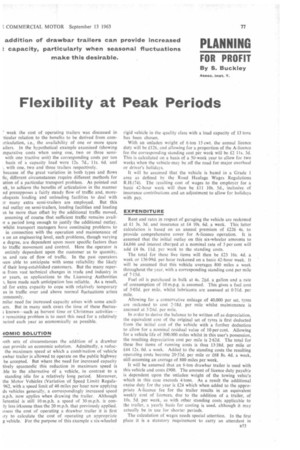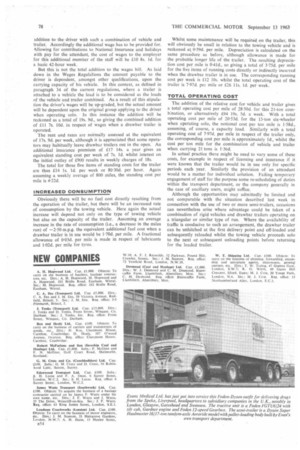Flexibility at Peak Periods
Page 79

Page 80

If you've noticed an error in this article please click here to report it so we can fix it.
By S. Buckley Assoc. Inst T.
7 week the cost of operating trailers was discussed in licular relation to the benefits to be derived from cornirticulation, i.e., the availability of one or more spare aiiers. In the hypothetical example examined (showing mparalive costs when using one, two or three semiwith one tractive unit) the corresponding costs per ton basis of a capacity load were 12s. 7d., I Is. 6d. and with one, two and three trailers respectively.
because of the great variation in both types and flows tic, different circumstances require different methods for ution of a particular transport problem. As pointed out .ek, to achieve the benefits of articulation in the manner ed presupposes a fairly steady flow of traffic and, moreidequate loading and unloading facilities to deal with r many extra semi-trailers are employed. But this naI outlay on semi-trailers, loading facilities and loading in be more than offset by the additional traffic moved, assuming of course that sufficient traffic remains availir a period long enough to justify the additional outlay. whilst transport managers have continuing problems to in connection with the operation and maintenance of a on an engineering level, such problems, though varying e degree, are dependent upon more specific factors than to traffic movement and control. Here the operator is entirely dependent upon the customer as to quantity. Na and rate of flow of traffic. In the past operators oeen able to anticipate with some reliability the likely -4 their long-established customers. But the many reperis from vast technical changes in trade and industry in ar years, as applications to the Licensing Authorities
have made such anticipation less reliable. As a result, for extra capacity to cope with relatively temporary es in traffic over and above normal fluctoations arises 3ommonly, milar need for increased capacity arises with some ancilcrs. But in many such cases the time of these fluctua; known—such as harvest time or Christmas activities— remaining problem is to meet this need for a relatively )eriod each year as economically as possible.
110M10 SOLUTION ooth sets of circumstances the addition of a drawbar can provide an economic solution. Admittedly, a reduethe maximum speed at which a combination of vehicle awbar trailer is allowed to operate on the public highway be accepted. But where the need for increased capacity tively spasmodic this reduction in maximum speed is .ble to the alternative of a vehicle, in contrast to a standing idle for a relatively long period. Moreover, the Motor Vehicles (Variation of Speed Limit) Regula962, with a speed limit of 40 miles per hour now applying ds vehicles generally, a correspondingly increased speed n.p.h. now applies when drawing the trailer. Although ferential is still 10 m.p.h. a speed of 30 m.p.h. is conly less irksome than the 20 m.p.h. that preview* applied. issess the cost of operating a drawbar trailer it is first Lry to calculate the cost of operating an appropriate g vehicle. For the purpose of this example a six-wheeled rigid vehicle in the quality class with a load capacity of 13 torts has been chosen.
With an unladen weight of 6 ton 15 cwt. the annual licence duty will be £126, and allowing for a proportion of the A-licence fee the corresponding standing cost per week will be £2 Ils. 3d. This is calculated on a basis of a 50-week year to allow for two weeks when the vehicle-may be off the road for major overhaul or driver's holidays.
It will be assumed that the vehicle is based in a Grade 1 area as defined by the Road Haulage Wages Regulations R.1-1,(74). The resulting cost of wages to the employer for a basic 42-hour week will then be £11 10s. 5d., inclusive of insurance contributions and an adjustment to allow for holidays with pay.
EXPENDITURE Rent and rates in respect of garaging the vehicle are reckoned at £1 3s. 3d. and insurance at £4 10s. 6d. a week. This latter calculation is based on an annual premium of £226 4s. to provide comprehensive cover for A-licence operation. It is assumed that the initial outlay on this six-wheeler amounts to £4,046 and interest charged at a nominal rate of 5 per cent will add £4 Os. ltd, per week to the standing costs.
The total for these live items will then be £23 16s. 4d. a week or 136.09d. per hour reckoned on a basic 42-hour week. It will be assumed that this vehicle averages 800 miles a week throughout the year, with a corresponding standing cost per mile of 7-15d.
Fuel oil is purchased in bulk at 4s. 2-1-d. a gallon and a rate of consumption of 10 m.p.g. is assumed. This gives a fuel cost of 5.03d. per mile, whilst lubricants are assessed at 03 Id. per mile.
Allowing for a conservative mileage of 40,000 per set, tyres are reckoned to cost 2-I8d. per mile whilst maintenance is assessed at 3-24d. per mile.
In order to derive the balance to be written off as depreciation, the equivalent cost of the original set of tyres is first deducted from the initial cost of the vehicle with a further deduction to allow for a nominal residual value of 10 per cent. Allowing for a vehicle life of 300.000 miles whilst in this user's possession, the resulting depreciation cost per mile is 2-62d. The total for these five items of running costs is thus 13-38d. per mile or £44 12s. Od. a week. Added to the standing costs the resulting operating costs become 20-53d. per mile or £68 8s. 4d. a week, still assuming an average of 800 miles per week.
It will be assumed that an 8-ton drawbar trailer is used with this vehicle and costs £900. The amount of licence duty payah:e is dependent upon the unladen weight of the towing yehiee which in this case exceeds 4 tons. As a result the additional excise duty for the year is £24 which when added to the appropriate A-licence fee for the trailer results in an equivalent weekly cost of licences, due to the addition of a trailer, of 10s. 5d. per week, as with other standing costs applicable to the trailer, a yearly basis for costing is used, although it may actually be in use for shorter periods.
The calculation of wages needs special attention. In the first place it is a statutory requirement to carry an attendant in B53 Addition to the driver with such a combination of vehicle and trailer. Accordingly the additional wage has to be provided for. Allowing for contributions to National Insurance and holidays with pay for the attendant, the cost of wages to the employer for this additional member of the staff will be £10 8s. Id. for a basic 42-hour week,
But this is not the total addition to the wages bill. As laid down in the Wages Regulations the amount payable to the driver is dependent, amongst other qualifications, upon the carrying capacity of his vehicle. In this context, as defined in paragraph 34 of the current regulations, where a trailer is attached to a vehicle the load is to be considered as the loads of the vehicle and trailer combined. As a result of this stipulation the driver's wages will be up-graded, but the actual amount will be dependent upon the original group applying to the driver when operating solo. In this instance the addition will be reckoned as a total of 19s. 9d., so giving the combined addition of £11 7s. 10d. in respect of wages when a drawbar trailer is operated.
The rent and rates arc normally assessed at the equivalent of 17s. 9d, per week, although it is appreciated that some operators may habitually leave drawbar trailers out in the open. An additional insurance premium of £17 14s. a year gives an equivalent standing cost per week of 7s. Id. whilst interest on the initial outlay of £900 results in weekly charges of 18s.
The total for these five items of standing costs for the trailer are thus £14 Is. ld. per week or 80-30d. per hour. Again assuming a weekly average of 800 miles, the standing cost per mile is 4-22d.
INCREASED CONSUMPTION
Obviously_ there will be no fuel cost directly resulting from the operation of the trailer, but there will he an increased rate of consumption by the towing vehicle. Here again the actual increase will depend not only on the type of towing vehicle but also on the capacity of the trailer. Assuming an average increase in the rate of consumption (i.e., a decrease in the miles run) of —2-50 m.p.g. the equivalent additional fuel cost when a drawbar trailer is in use would be 1.70d. per mile. A fractional allowance of 0-03d. per mile is made in respect of lubricants and I.02d. per mile for tyres. Whilst some maintenance will be required on the trailer, this will obviously be small in relation to the towing vehicle and is reckoned at 0-59d. per mile. Depreciation is calculated on the same procedure as before, although allowance is made for the probable longer life of the trailer, The resulting depreciation cost per mile is 0-41d., so giving a total of 3-75d. per mile for the five items of running costs directly or indirectly incurred when the drawbar trailer is in use. The corresponding running cost per week is £12 10s. whilst the total operating cost of the trailer is 7.97d. per mile or £26 1 ls. Id. per week.
TOTAL OPERATING COST
The addition of the relative cost for vehicle and trailer gives a total operating cost per mile of 28.50d. for this 2I-ton comb:nation, or alternatively £94 19s. 5d. a week. With a total operating cost per mile of 20-53d. for the 13-ton six-wheeler when operating solo, the notional cost per ton mile is I-58d., assuming, of course, a capacity load. Similarly with a total operating cost of 7.97d. per mile in respect of the trailer only, the corresponding cost per mile is approximately Id., whilst the cost per ton mile for the combination of vehicle and trailet when carrying 21 tons is 1-36d.
In actual, practice there might be need to vary some of these costs, for example in respect of licensing and insurance if it were known that the trailer would be in use only for specific periods each year. Similarly the provision of an attendant would be a matter for individual solution. Failing temporary engagement of staff for the purpose some re-scheduling of duties within the transport department, or the company generally in the case of ancillary users, might suffice.
Although the opportunities may admittedly be limited and not comparable with the situation described last week in connection with the use of two or more semi-trailers, occasions can nevertheless arise where advantage could be taken of a combination of rigid vehicles and drawbar trailers operating on a triangular or similar type of run. Where the availability of traffic is conducive to such an arrangement, the drawbar trailer can be unhitched at the first delivery point and off-loaded and subsequently reloaded whilst the towing vehicle proceeds solo to the next or subsequent unloading points before returning for the loaded trailer.




















































































































